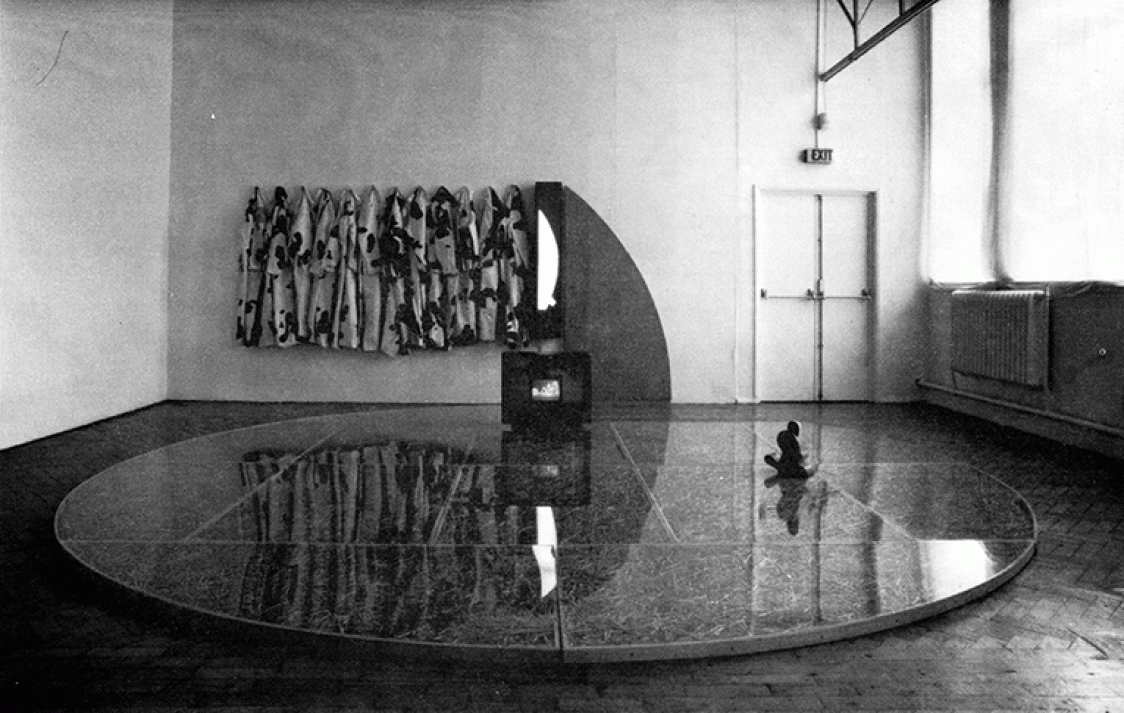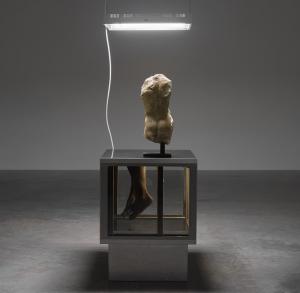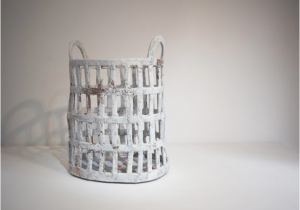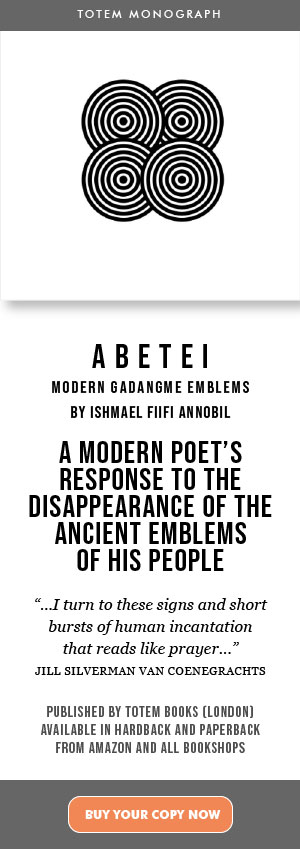HATHOR: MILKY WAY
An installation by the Yugoslav artist, Radovan Kraguly
Chapter Arts Centre, Cardiff and Weyside Gallery, Builth Wells, April -June 1995
Reviewed by Ishmael Annobil and George Keane
ONCE you had finished conversing with Radovan Kraguly, you felt unusually inspired to churn out a vigorous critique that was at once momentous and indelible. But this kind of personal musing is unnatural, if invasive, in our world of honed-out, premonitory cynicism. The world of art criticism, that is.
Yet the invasion was real; a sobering punch of sorts that meets your fastidious prying for imperfection with equal gusto. In this case, however, the punch was a reward. A reward won for resolute respect for a major Twentieth Century artist.
Kraguly's central theme in Hathor: Milky Way, was (is) the manipulation and consumption of animals by man. For the purposes of his discourse we were confronted by a recurring, ubiquitous COW hide motif, the cow being the archetypal victim of man, juxtaposed with sublime reminders of man's insidious power tools of exploitation.
Here also, Kraguly's subject managed to rise above the victimism and transform solidly into a being on a par with humankind in all ways, barring the physiological differences. A being capable of extracting from our cold hearts, the same pathetic and altruistic responses that we are obliged to show towards fellow 'humans'.
Furthermore, we were almost called upon, by near magical stealth, to pay obeisance to our seminal sources of sustenances. The cow cried out to you; a majestic and unapologetic cry from our common synoecism.
Reflection, a piece characterised by packed grass in glass cases topped by a video dance piece by humans in cow's clothing, was a succinct transposition of man and animal. You were forced to perceive yourself as the subject of human manipulation and imminent slaughter; the claustrophobia, the instinctive clustering together for comfort, the cyclical and confused urge for a freedom that never comes - death dance.
For the Chapter exhibition, the costumes once worn by dancers from the Beavis Foundation in Omaha for the first U.S. showing of the piece, were hung to the back of the reflection, "shed like does a moulting snake".
You withdrew squeamishly to take cover behind something less challenging, only to be confronted in a side room by an awe inspiring monolithic representation of our dark minds: Processus.
A complete socio-economic theory, Processus nestles in the cool room and swathes the floor with its gravity, its torso swelled to excess by our obsequious offering of hay, its back pierced with a shepherd's crook and draped with a funereal cowhide patterned banner.
Its wooden head tapers off into a square eyehole whose cornea slides askance
with video images of the industrial milking line: cows stood on stiff legs amidst all the suckling harnesses, the scene, punctuated with jarring, metallic industrial noises. Opposite, with its viewpoint partially blocked by a leaded aquiline, sculptural intermission, Processus was forced to see a dustbin filled to the brim with empty milk containers.
Before Kraguly, there was, understandably, a haphazard animal rights lobby; after Kraguly, the message has moved on to a higher level. We are now in the hands of a deft polemicist. The message is clear. He has succeeded in proclaiming what is normally only hinted at: animal is humankind!
By the close of the Chapter exhibition, the shepherd's crook on Processus' back had taken on a fateful spider's web. One came away converted. Radovan Kraguly's art, ulterior in essence, dwells on the artist's own split level existence: village-city. An undying nostalgia for a rural birthplace, Prijedor in Yugoslavia, vis-a-vis the practical need to abide the false excitement of city life.
Spatial dichotomy, duality or polarity, what takes place in that interface between the two zones is "lots of wondering, anguish". So he must continue to exist on the two planes, sapping the all-important nectar of melancholia.
He mourns the loss of human contact and the sense of affinity with animals; worst still, the manipulation and dismemberment of animals for human consumption, a condition that for now requires a total dehumanization of 'edible beings' by man, so as to indulge without much compunction.
Kraguly was born in 1936. He studied painting and printmaking in Belgrade's Academy Of Fine Arts and the Central School Of Art and Craft, London in the Sixties. But that was where orthodoxy ended for him - He works his own idiom.
Kraguly has built his reputation internationally working in painting, sculpture, performance and video; exhibiting in France, America, Italy, Slovenia and his home country of Bosnia. He divides his time between his studios in the centre of Paris and on a small farm in Builth Wells in mid Wales. His blueprint for art: "Art for all".
(This article is the first in a series of articles culled from the defunct cult newspaper Circa21, Wales' first serious arts newspaper, founded and edited by Ishmael Fiifi Annobil, ably assisted and subsidised by founding section editors George Keane and Michael Bowden. It was refused funding by the Welsh Art Council - Wales has yet to come up with a credible replacement! )





